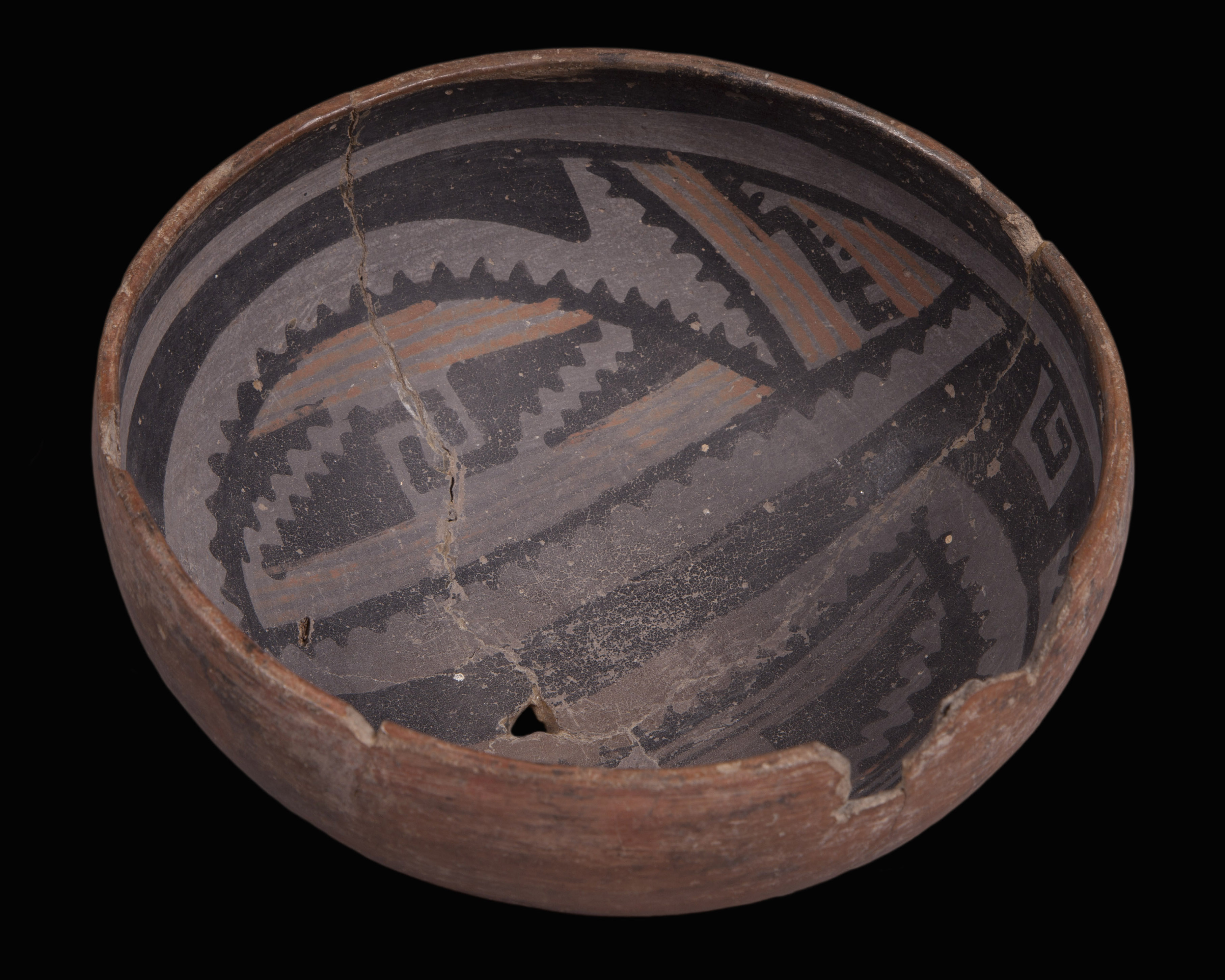
Los Muertos Polychrome bowl, Tonto National Monument. Click the image to open the Los Muertos Polychrome gallery.
Los Muertos Polychrome is a Roosevelt Red Ware similar in all ways to Gila Polychrome, but with the addition of red painted lines adjacent to black designs. This type of pottery is found in the Verde Valley, the Agua Fria-Perry Mesa area, the lower Salt River valley, the middle Gila valley, the Santa Cruz flats, the Tonto Basin, and as far east as Safford, and may possibly extend throughout the range of Gila Polychrome (the Agua Fria River to the Rio Grande, and the Little Colorado River to Sonora and Chihuahua).
Archaeological Culture: Salado
Date Range: A.D. 1390-1450.
Construction: By coiling.
Firing: In an oxidizing atmosphere.
Core Color: Brick-red, tan, gray to black.
Carbon Streak: Common.
Temper: Moderately abundant fine water-worn sand.
.
Surface Finish:
-
- Bowl interiors: Well-smoothed and coated all over with thick slip; usually crazed; slightly gritty; never polished.
- Bowl exteriors: coated with thin slip; usually well-polished with horizontal striations; occasionally also coated from rim downward about halfway to base with the same slip as used on interiors.
- Jar exteriors: Well-smoothed; coated with the same slip as used on bowl interiors (but not including the rim to about midway between the base and greatest body diameter; unpolished; usually gritty; crazed; inside necks and area below (white) slip, coated with thin (red) wash; well-polished.
Surface Color: Bowl exteriors, red, sometimes white in part; bowl interiors, creamy white; jar exteriors, red and white; bases and other areas from which wash has weathered, color dull brownish to brick-red.
Forms: Bowls, jars, mugs.
Vessel Thickness: 4 to 7.4 mm; average, 6 mm (jars).
Decoration:
- Paint: Red and black over a white slip.
- Pigments: Black carbon and red hematite.
- Design: Bowl interiors usually completely covered in all over layout, frequently with fold design or horizontal band leaving open circle in bottom; decoration never carried to the rim; rim usually plain, occasionally ticked; bowl exteriors usually unpainted; on bowls having exterior white slip appears decorative band similar to band on interiors, with horizontal stripe just below rim, stripe almost always broken; jar decoration has horizontal stripe, usually broken, encircles shoulder, dividing white slipped area into two zones, one around the neck and one around the body; zones painted in bands containing elements similar to elements on bowl exteriors; rarely horizontal stripe just below rim, leaving only one decorative zone on white slipped area. Design elements consist of predominantly solid elements, running largely to tapering triangles and scrolls with scalloped edges; also solid steps, keys and small mazes; hachuring in triangular panels fairly frequent; horizontal stripe always present, usually just below rim, sometimes one or two inches below rim, dividing surface into two areas, decorated with horizontal band above stripe with all over lay-out below, stripe usually broken.
Comparisons: Characteristics are typical of Gila Polychrome, except that Los Muertos Polychrome has the addition of narrow, red lines alongside black paint on white-slipped surfaces.
Other Names: Las Colinas Polychrome, Gila Polychrome/Hatched, Gila Polychrome/Trichrome Variety, Perry Mesa Polychrome.
Compiled from the following sources:
Colton, Harold S., and Lyndon L. Hargrave. (1937) Handbook of Northern Arizona Pottery Wares. Museum of Northern Arizona Bulletin 11, Flagstaff, Arizona.
Lyons, Patrick D. (2013) Placing the Tonto Cliff Dwellings in the Larger Context of the Tonto Basin and the Southern US Southwest. Final Report of WNPA Research Project 06:09: Investigating Ancient Dynamics by Studying Salado Ceramic and Obsidian. On file at Tonto National Monument.
Compiled by:
April Peters and Meghann M. Vance, Northern Arizona University Anthropology Laboratories
